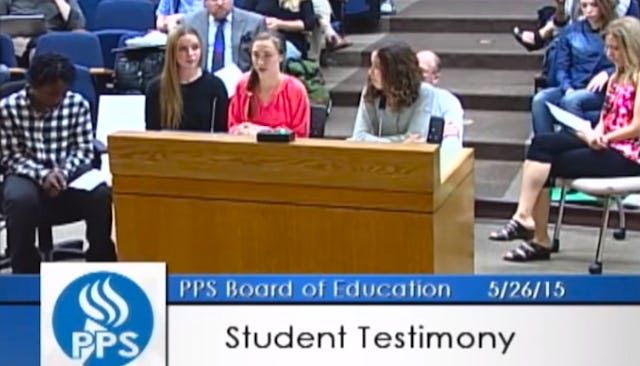These Brave 7th Grade Girls Fought To Change Their School's Dress Code -- And Won

A group of 7th grade girls testified before the school board about how unfair their dress code was
When most of us were in middle school, we were probably obsessively reading Teen Beat and trying to one-up each other with our sweet Lisa Frank school supplies. Today’s middle schoolers are a bit more savvy and a lot more socially aware if these incredible 7th grade girls who fought their school’s dress code are any indication.
Oh yeah, and they won.
According to Upworthy, four female students from a Portland, Oregon middle school testified last year in front of the school board about the dress code. Tired of being humiliated over their clothing choices, these amazing young ladies decided to do something about it. The best part is, the school board listened and worked with them on making huge changes to the rules.
Alisa, one of the four students, told the board, “The only reason I go to school is to get my education. When I get dressed in the morning, my intention is not to provoke or be sexualized. My intention is to feel comfortable in my own skin.”
Kind of sad that a middle schooler has to plead her case like this to a bunch of adults who should know better, but such is the world we live in. Girls and women are constantly having to fight for equal treatment and to not be considered a “distraction” to the education of a boy.
Fellow student Sophia said, “My problem with the dress code is that 100% of the students that get sent home are female. In a way, you’re telling a girl that boys are more entitled to their education than she is. And I don’t think that’s acceptable.”
Bingo. It’s absolutely unacceptable in every way. Alisa recounted a situation with a female student where her skirt was “too short” and she was forced to sit in the principal’s office for hours while staff tried getting a hold of her parents. As Alisa points out, not only did she miss out on her education that day, she was also embarrassed by the ordeal.
And before anyone clutches pearls and says girls need dress code stipulations more than boys because of the varying kinds of clothing they can wear, consider that these students aren’t saying there should be no dress code. Just that it shouldn’t focus on so many female body parts, obsessing over specifics like midriff, shoulder, collarbone, legs and visible bra straps.
After hearing their testimony, the school board agreed there needed to be changes to the current rules, so a committee was formed. It was made up of students (including Sophia), parents, teachers and community leaders like Lisa Frack, president of the Oregon chapter of the National Organization of Women. “We don’t want to link clothing and learning. You can’t learn math better or worse whether you have a tie on or a collared shirt or a tank top,” Frack said.
Amen.
The result? A relatively gender-free dress code devoid of terms like “bare midriff” and “plunging necklines.” Gone are the mentions of “sexually suggestive clothing.” It asks that students refrain from obvious missteps like clothing depicting pornography, nudity, alcohol or tobacco products and hate speech. It even has a clause protecting kids who wear clothing relating to their religious beliefs, such as a head scarf.
There will be no more dings for a visible bra strap, no more bans on hoodies and hats, just a request that the face be visible and not interfere with another student or staff member’s line of site. It’s all entirely reasonable and doesn’t specifically call out girls. It treats them like human beings, which is refreshing.
If the dress code is a success, it will mean fewer students missing class time for total nonsense. It’s rolling out this fall for the first time, and Frack is hopeful it will serve as a model for other schools who need to revise their dress codes too.